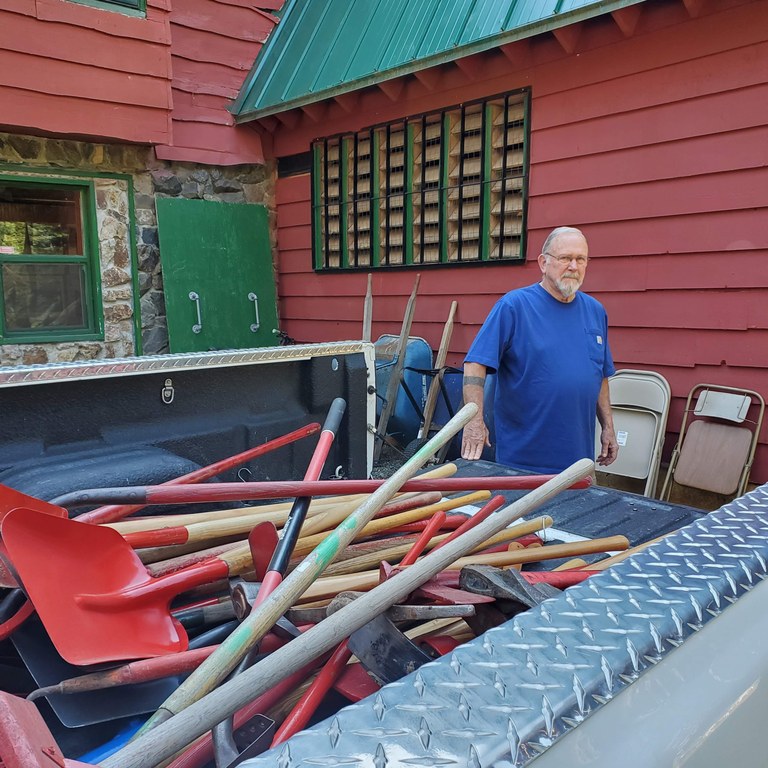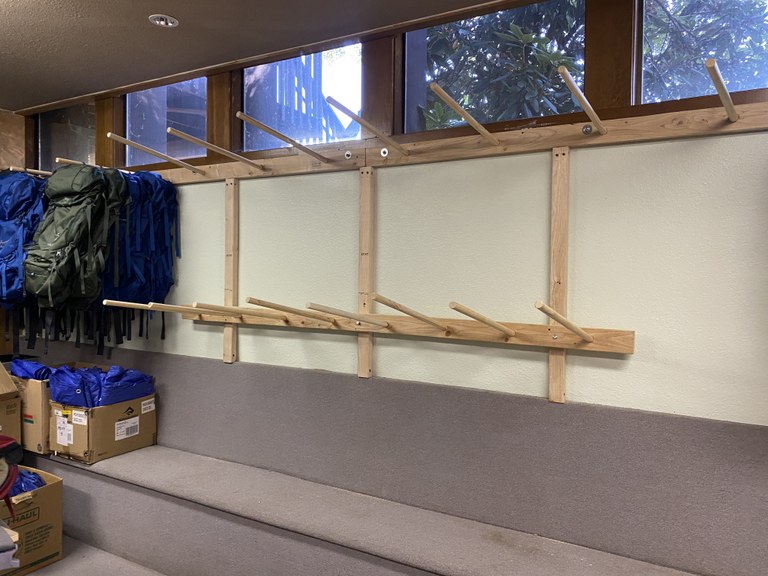 Washington Trails
Association
Washington Trails
Association
Trails for everyone, forever
For 18 years, John Mackenzie has been using his carpentry skills to support WTA's work, including our trailwork and Outdoor Leadership Training programs.| By Anna Roth
It’s fairly common to look forward to retirement as a time to step away from the work that filled your days for decades. Not for John Mackenzie. A carpenter and construction project manager by trade, John retired around 2007, and almost immediately began building things with WTA on trail. Around 2018, he shifted to volunteering to support WTA staffers who make our programs possible.
He started by building storage in our North Bend packing facility, making it possible for WTA to host volunteer vacations. He’s built ingenious storage solutions in our gear libraries, making it easier for groups to rent gear and. And he helps with tool maintenance, so volunteers have sharp tools.
John discovered WTA from a post by volunteer crew leader Bob Adler on NWHikers, an online hiking forum.
“I saw (Bob’s) post about restoring Kelly Butte Lookout shortly after I retired, and I thought, ‘Carpentry, cool! Lookouts, cool!’ I think I spent every other weekend there the rest of the summer.”
Once they finished that project, Bob convinced John to give trail maintenance a try. So when WTA started working in the Skykomish District, so did John. He was a regular at those work parties led by former crew leader Zack McBride. The following spring he joined a volunteer vacation with Lisa Black, a longtime crew leader, former board member and dedicated, charismatic volunteer.
Bob, Zack and Lisa had set the stage, offering camaraderie and fun projects, and John was hooked. He did years of “dirt work,” with a strong preference for construction projects.
“My head works in inches and feet and eighths and quarters and solutions to problems,” he said. “It’s what I did when I was a project manager for 30 years.”
John’s entire career was in construction. He was a carpenter for 10 of those years, where he had access to “just about every tool you can think of.” Later he worked on contracts for large commercial projects, but once you learn carpentry, you don’t forget those skills. And lucky for us, John loves carpentry and believes in sharing knowledge.

John helps WTA staff and volunteers by keeping our tools in great shape and creating ways to store them efficiently. Photo by MJ Sampang.
“How can I know how to do that and not want to share?” he said. “I enjoy it. It’s not work to me. Carpentry isn’t work.”
Which is probably why he spends so much time building stuff for WTA. When he was on-trail, there was always a construction project available, and when Jen Gradisher — now our trails director, then a crew leader — had a project, they’d call on John for assistance. Each time Jen or Zack told him about a puncheon or a bridge project, he’d put together a materials list and provide instructions on how to build the structure.
Having those instructions and neatly sorted materials simplified construction hugely. It was crucial to WTA in offering a good volunteer experience on our work parties.
Simplifying and streamlining the volunteer experience is something John believes is central to getting people to feel part of WTA’s community. It’s also how he shifted his focus to projects that support WTA’s programs, starting with tool sharpening.
John is serious about this. In 2015, he attended a weeklong crosscut saw maintenance class at the Ninemile Remount Depot and Historic Ranger Station outside of Missoula, Montana. For 40 hours, they practiced crosscut sharpening, a manual task that takes precision and focus in a world of increasingly automated practices. They also had a 4-day class on ax maintenance.
John was fascinated by the whole compound. “Their focus at the station is in teaching many of the lost skills they don’t want to lose forever.”
When he returned, he brought that expertise to WTA’s tools, which he maintains year-round in his at-home shop.
“Good folks come out on trail,” he said. “Even if they’re not skilled when they get on a project, it’ll come in time. You just have to ensure they come back. You keep really nice-looking, well-kept tools in volunteers’ hands, and at the end of the day they’ll get more done and they’ll come back.”
Erin McMillin, the WTA staffer who oversees volunteer vacation prep and the tool cache in North Bend, reflects on John’s commitment to maintaining and storing those sharp tools. 
Freshly painted tools. Photo by MJ Sampang.
“I’d estimate he paints and sharpens almost 300 tools in a year,” Erin said. “Sharpening crosscut saws is a tedious and challenging process. It’s a difficult skill. ... It’s amazing to have a skilled sharpener in our community.”
Spending all that time in the tool cache and the facility in North Bend, John noticed some improvements needed to be made. When WTA first took up residence in North Bend, it was a drafty, open garage with a rat problem. John saw a solution and built floor-to-ceiling shelves to create a more sanitary and pleasant workspace to prep all of the supplies for our volunteer vacations. Every year, he does a little more to improve it.
“If we say we need more storage, he’ll start planning the shelves before I finish my sentence, and have them built by the end of the week,” Erin said.
He’s made an equal impact on the gear libraries where the gear for our Outdoor Leadership Training (OLT) program is stored. MJ Sampang, who works out of the Pierce County location, says John has been an integral part of the OLT library organization.

John helped create these storage systems to help organize gear in WTA's Pierce County gear library. Photo by MJ Sampang.
“When John noticed that this location was small and mighty, he added wheels to the table to make the space fun and dynamic,” she said. “John also built all the dowels and shelves that hold snowshoes, trekking poles and 125 colorful backpacks.”
The gear libraries help various community groups take their members outside by making gear available to group leaders after a training session. They’re key to helping introduce young people to the outdoors who wouldn’t otherwise be able to get outside, and John believes OLT is the key to the future of WTA.
WTA’s 30th anniversary of trail work is this year. While we have been celebrating that anniversary all year, we wouldn’t be able to do the work and programming we do as an organization without commitments from people like John. We’re lucky to have his generous spirit and the time he dedicates to our mission.
It’s a great opportunity,” John said. “The kids that take to it are gonna want more. It’s a natural transition from using gear from the lending library, to spending a few day trips volunteering on trail, to becoming orange hats (assistant crew leaders) and loving WTA”
We agree! Thanks to John and volunteers like him who help make all our programs possible.